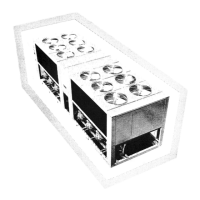Do you have a question about the Carrier 30GTR and is the answer not in the manual?
Microprocessor-based control system for chiller operation and monitoring.
Benefits of dual independent circuits and advanced controls for energy savings.
Modular design allows for various installation configurations and future expansion.
Factory tested components and robust design ensure long-term performance.
Unit manufactured in ISO 9001 and 14001 certified facilities for quality assurance.
Explanation of the coding system for model numbers including size, type, and options.
Detailed specs including weight, refrigerant charge, compressor type, and coil details.
Top, side, and end views showing overall unit dimensions and key features.
Table providing precise dimensions for different unit sizes.
Recommended operating ranges and limits for leaving chilled fluid temperature.
Minimum and maximum flow rates and loop volumes for optimal performance.
Measures to prevent freeze-up, including antifreeze solutions and system design.
Importance of adequate fluid volume for temperature stability and accuracy.
Requirements for starting and operating the unit at low outdoor temperatures.
Use and correction factors for inhibited ethylene glycol in low-temperature applications.
Steps to identify the correct unit based on capacity and operating conditions.
Procedures for calculating corrected water flow rate and cooler pressure drop.
Tables showing compressor displacement percentages at various load steps.
Electrical data including voltage, current ratings (MCA, MOCP), and fuse sizes.
RLA and LRA values for individual compressors across different unit sizes.
Fan quantities and FLA values for each unit size.
Explanations of electrical terms and important notes for installation.
Overview of the central executive routine controlling unit operations and processes.
Function of the EXV in controlling refrigerant flow and maintaining superheat.
Methods used for managing chiller capacity, including staging and temperature reset.
Safety functions, fault detection, and troubleshooting display capabilities.
Diagrams illustrating typical piping and wiring connections for unit installation.
Overview of the chiller system and manufacturing quality assurance standards.
Detailed specs for cabinet, fans, compressors, cooler, and condenser components.
Specific control capabilities, safety interlocks, and diagnostic functions of the microprocessor.
Information on unit start-up, load control, and operational features like lead/lag.
Microprocessor-based control system for chiller operation and monitoring.
Benefits of dual independent circuits and advanced controls for energy savings.
Modular design allows for various installation configurations and future expansion.
Factory tested components and robust design ensure long-term performance.
Unit manufactured in ISO 9001 and 14001 certified facilities for quality assurance.
Explanation of the coding system for model numbers including size, type, and options.
Detailed specs including weight, refrigerant charge, compressor type, and coil details.
Top, side, and end views showing overall unit dimensions and key features.
Table providing precise dimensions for different unit sizes.
Recommended operating ranges and limits for leaving chilled fluid temperature.
Minimum and maximum flow rates and loop volumes for optimal performance.
Measures to prevent freeze-up, including antifreeze solutions and system design.
Importance of adequate fluid volume for temperature stability and accuracy.
Requirements for starting and operating the unit at low outdoor temperatures.
Use and correction factors for inhibited ethylene glycol in low-temperature applications.
Steps to identify the correct unit based on capacity and operating conditions.
Procedures for calculating corrected water flow rate and cooler pressure drop.
Tables showing compressor displacement percentages at various load steps.
Electrical data including voltage, current ratings (MCA, MOCP), and fuse sizes.
RLA and LRA values for individual compressors across different unit sizes.
Fan quantities and FLA values for each unit size.
Explanations of electrical terms and important notes for installation.
Overview of the central executive routine controlling unit operations and processes.
Function of the EXV in controlling refrigerant flow and maintaining superheat.
Methods used for managing chiller capacity, including staging and temperature reset.
Safety functions, fault detection, and troubleshooting display capabilities.
Diagrams illustrating typical piping and wiring connections for unit installation.
Overview of the chiller system and manufacturing quality assurance standards.
Detailed specs for cabinet, fans, compressors, cooler, and condenser components.
Specific control capabilities, safety interlocks, and diagnostic functions of the microprocessor.
Information on unit start-up, load control, and operational features like lead/lag.












